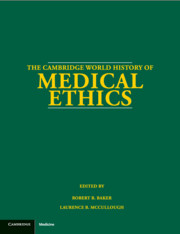Book contents
- Frontmatter
- PART I AN INTRODUCTION TO THE HISTORY OF MEDICAL ETHICS
- PART II A CHRONOLOGY OF MEDICAL ETHICS
- PART III DISCOURSES OF MEDICAL ETHICS THROUGH THE LIFE CYCLE
- PART IV THE DISCOURSES OF RELIGION ON MEDICAL ETHICS
- 9 The Discourses of Hindu Medical Ethics
- 10 The Discourses of Buddhist Medical Ethics
- 11 The Discourses of Confucian Medical Ethics
- 12 The Discourses of Early Christian Medical Ethics
- 13 The Discourses of Orthodox Christian Medical Ethics
- 14 The Discourses of Roman Catholic Medical Ethics
- 15 The Discourses of Protestant Medical Ethics
- 16 The Discourses of Jewish Medical Ethics
- 17 The Discourses of Islamic Medical Ethics
- PART V THE DISCOURSES OF PHILOSOPHY ON MEDICAL ETHICS
- PART VI THE DISCOURSES OF PRACTITIONERS ON MEDICAL ETHICS
- PART VII THE DISCOURSES OF BIOETHICS
- PART VIII DISCOURSES ON MEDICAL ETHICS AND SOCIETY
- Appendix: Biographies: Who Was Who in the History of Medical Ethics
- Bibliography
- Index
16 - The Discourses of Jewish Medical Ethics
from PART IV - THE DISCOURSES OF RELIGION ON MEDICAL ETHICS
Published online by Cambridge University Press: 28 May 2012
- Frontmatter
- PART I AN INTRODUCTION TO THE HISTORY OF MEDICAL ETHICS
- PART II A CHRONOLOGY OF MEDICAL ETHICS
- PART III DISCOURSES OF MEDICAL ETHICS THROUGH THE LIFE CYCLE
- PART IV THE DISCOURSES OF RELIGION ON MEDICAL ETHICS
- 9 The Discourses of Hindu Medical Ethics
- 10 The Discourses of Buddhist Medical Ethics
- 11 The Discourses of Confucian Medical Ethics
- 12 The Discourses of Early Christian Medical Ethics
- 13 The Discourses of Orthodox Christian Medical Ethics
- 14 The Discourses of Roman Catholic Medical Ethics
- 15 The Discourses of Protestant Medical Ethics
- 16 The Discourses of Jewish Medical Ethics
- 17 The Discourses of Islamic Medical Ethics
- PART V THE DISCOURSES OF PHILOSOPHY ON MEDICAL ETHICS
- PART VI THE DISCOURSES OF PRACTITIONERS ON MEDICAL ETHICS
- PART VII THE DISCOURSES OF BIOETHICS
- PART VIII DISCOURSES ON MEDICAL ETHICS AND SOCIETY
- Appendix: Biographies: Who Was Who in the History of Medical Ethics
- Bibliography
- Index
Summary
INTRODUCTION
“Jewish Medical Ethics” was established as a recognized subspecialty by Immanuel Jakobovits (1921–1999), the late Chief Rabbi of the United Kingdom, in Jewish Medical Ethics, (1959). In developing this field Jakobovits and others have drawn from sources going back as far as 3,000 years and particularly on the halakhah, the Jewish tradition of normative discourse. Anyone interested in this subject needs to appreciate the nature of biblical law and rabbinic halakhah, and to gain some familiarity with those classical teachings that have particular relevance to medical issues. Because the field is so vast, what follows is intended as a set of illustrative examples rather than as a comprehensive survey.
BIBLICAL FOUNDATIONS
Within the twenty-four books canonized in the Hebrew Bible, the laws are found primarily in the “Five Books of Moses” (the Pentateuch). Revered by Jews as the document of God's revelation, these constitute Torah in its narrow sense, as distinguished from Torah in the broad sense of instruction, which encompasses all valid teachings in Judaism down to the present. These laws are not presented as arbitrary divine commands; rather, the text emphasizes their sense and purpose, embedded in a narrative of God's relationship, first with humankind in general and then with the Israelite people in particular.
The Bible opens with the story of the Creation, whose apex is the creation of humans in God's image.
- Type
- Chapter
- Information
- The Cambridge World History of Medical Ethics , pp. 264 - 269Publisher: Cambridge University PressPrint publication year: 2008

